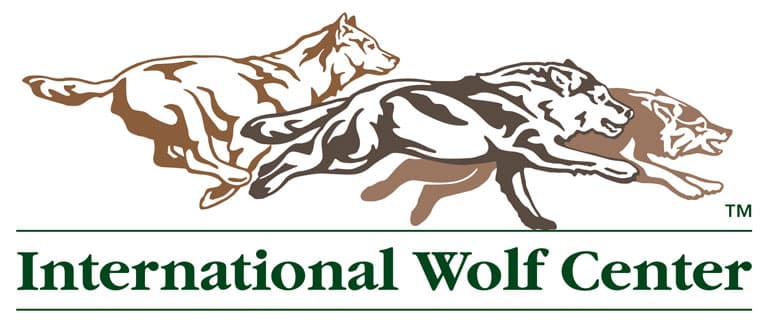The wolves are doing well over the Christmas Holidays. Curator Lori Schmidt has been in every day checking on them and they had a full deer carcass on Christmas Eve to keep them well fed during the holiday, when limited staff are on site. Grizzer has been very active lately instigating the pack to chase him as he runs in and out of the den. Dominance behavior seems to have calmed a bit, but howling bouts are increasing. Fresh snow tracks reveal recent visits to the fence from a fox, coyote and even a white tail deer walked up to the back fence. This has likely increased the captive wolves excitement levels. Lori Rhodes visited the Center on November 11th and 12th and contributes this week's photos of the Exhibit Pack.
Archives
Written by 'Wolves at Two Years" program participants Betty Magnuson and Jennifer Ell. The program participants cleaned the pond before the center opened while the wolves were locked in holding pen. After the release to the main enclosure, Maya was especially curious while the ponds was refilling. In the afternoon, she rested on the edge of the pond with her back paw and tail in the water.
MacKenzie has been much more relaxed lately… Construction across the road is ongoing, but she's become much more tolerant of it lately. Staff did notice some increasing hip issues with MacKenzie, her age is catching up to her. Thanks to Pam Dolajeck for the pigs ears, MacKenzie tried to gather up 4 of them from her packmates, but the warm snow conditions sent the pigs ears sliding like a hockey puck. She did manage to eat 3 of them.
Lakota seems to keep the Retired Pack stimulated. During this morning's wolf check, she instigated a chase behavior that even stimulated Lucas to run after her. While the warmer weather has been slowed down the younger wolves, there seems to be an opposite effect on the older wolves. They are all much more active, with very good physical activity.
Shadow is by far the best example of a socialized wolf. He still keeps all of his natural instincts (that is why he might be the best leader for the pack), and he also shows how difficult it is for socialized wolves to transfer bonds. During the curator absence(she was at the wolf symposium), Shadow was seen approaching the fence everytime a car stopped, and howled after confirming it was not the curator. This is a behavior that makes the caring of this animals more challenging. He also shows more dominat behavior when the center is not open, and therefore, no intimidation from the crowd.
Lakota has been enjoying the excess deer we have on hand. Thanks to Peg Callahan, director of the Wildlife Science Center, who donated a truck load of deer in October, we have a full freezer. Also thanks to Krisy Raines and Kim Wheeler who drove the truckload of deer to Ely, and willingly unloaded it in the freezer. The ability to feed a natural food supply keeps the wolves stimulated and as you can see by the photos, in good condition. Also, thanks to Pam Dolacheck, who provided a bag of pigs ears for all the wolves on Christmas Day. They enjoyed their treat.
Malik is doing well, still trying to act dominant with Shadow and still getting chased up the hill by Shadow and Grizzer. Interactions have been much calmer than previously anticipated, most likely due to the warm weather. There is one winter issue that is on the minds of wolf care staff. Shadow seems to take on a much more defensive almost fear based behavior during winter time Behind the Scenes programs, bark howling with a tucked tail. While many program participants have observed this during the summer, he is much more stressed by groups in winter. Staff are very cautious about the impact of these groups on the dynamics of the pack. When Shadow shows this defensive and sometimes fearful posture, Malik immediately responds with a high tail and aggressive move to take advantage of Shadow's vulnerability. We certainly don't want a status change in rank order due to Behind the Scenes groups. Staff monitor Shadow's response closely and make the decision if a group stays or goes.
Grizzer killed a raven in the enclosure today. Generally, the ravens come in to feed off the carcass without incident. Sometimes, the wolves are faster than the ravens predict. Today was one of those days. Raven's have social behavior similar to wolves. After the raven was killed, the flock of remaining ravens followed Grizzer and landed in the trees above him, with intense alarm calls.
Shadow normally is a bit shy during the Saturday night feeding programs. He's the most anxious about strange humans, and the feeding program crowds with camera flashes usually keeps him off the carcass. This past Saturday, Curator Lori Schmidt and assistant curator, Donna Prichard entered the enclosure during the feeding to get video and still camera footage. With the presence of two handlers, Shadow became extremely excited and confident with the program. He stayed on the carcass long into the program and guarded Maya from Malik. There was some good opportunity for footage and images with the new camera, again, many thanks to John and Donna Virr for the camera donation.
During the medical exam for the arctics, the retired wolves watched intently on the action, with Lakota getting a view from atop the den box. Sorry, no photos, we were focused on the main pack today.

The International Wolf Center uses science-based education to teach and inspire the world about wolves, their ecology, and the wolf-human relationship.
